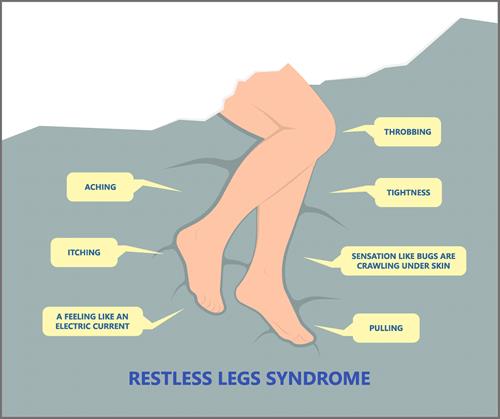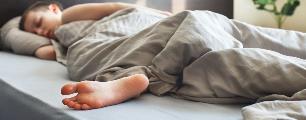What is Restless Legs Syndrome (RLS)?
Restless legs syndrome (RLS) is a neurological disorder. With RLS a child or adolescent will say that they have a strong feeling that they “need” to move their legs. These feelings are usually worse in the evening and at bedtime. They can also occur when a child has to sit still for a long time, such as on a long car ride. This urge to move is often accompanied by uncomfortable feelings in the legs. These feelings may be described as “creepy-crawly” or tingling. Some parents think their child’s complaints are “growing pains” or simply believe that their child is fidgety. Moving the legs usually makes the uncomfortable feelings better. Things that will help may include stretching or jiggling the legs, getting up and walking or running around, or simply tossing and turning. For some children, rubbing the legs may make them feel better.
Because of the leg discomfort and increased leg movements, it often takes a long time for a child or adolescent with RLS to fall asleep at bedtime. This results in not getting enough sleep. In addition, children with RLS often kick their legs or twitch when they are asleep, which are called “periodic limb movements.” These movements may disrupt sleep, and lead to feeling tired the next day. Unlike RLS, a child with periodic limb movements is usually not aware of the problem, although a parent may observe kicking and restless sleep.

What causes Restless Leg Syndrome?
RLS appears to be genetic. It often runs in families. Most children with RLS have a parent or grandparent with similar symptoms. In addition, certain things may make RLS worse. These include iron deficiency (with or without anaemia) and caffeine. Certain medications, such as antihistamines and the antidepressant fluoxetine (Prozac), may cause RLS. Some children with a chronic illness, such as diabetes, sickle cell, and kidney disease, are at increased risk for RLS.
What are the symptoms of Restless Legs Syndrome?
The symptoms of RLS include the following:
- Leg movements: Children and adolescents with RLS often have an irresistible “urge” or feeling that they “have” to move their legs. These movements can relieve the uncomfortable feelings. These movements can be shaking or kicking the legs. They may toss and turn while lying in bed. Some even need to walk or run around.
- Leg discomfort: Children or adolescents often describe these uncomfortable leg sensations as creepy-crawly, itching, burning, popping, tingling, or sometimes as painful. They may also use more colourful descriptions, such as “ants crawling on my legs” or “soda bubbling through my veins.” These feelings usually occur only at bedtime or are much worse at bedtime. They can, though, occur at other times, such as while sitting still in school or on long car rides.
 Difficulty falling asleep: Children and adolescents with RLS often take a long time to fall asleep because of the leg discomfort and need to move. They not only have problems falling asleep, but may also be wake up during the night.
Difficulty falling asleep: Children and adolescents with RLS often take a long time to fall asleep because of the leg discomfort and need to move. They not only have problems falling asleep, but may also be wake up during the night.
- Bedtime behaviour problems: Because of the difficulty falling asleep caused by RLS, some children may resist going to bed at night.
- Daytime problems: The difficulties falling asleep and staying asleep can lead being sleepy during the day. Also, problems with mood, behaviour, and school are common in children with RLS. They may also be hyperactive, impulsive, irritable, and have problems concentrating.
How is Restless Legs Syndrome diagnosed?
There is no test for RLS. Instead, the diagnosis is made based on the description of symptoms. A medical history and physical examination will also be done to make sure there are no other problems. Your doctor may order a blood test for low iron called a “serum ferritin level.” Finally, an overnight sleep study may be recommended to check for other sleep disorders, especially periodic limb movements. These can only be diagnosed with a sleep study.
How is Restless Legs Syndrome treated?
Treatment for RLS may involve any of the following.
- Healthy sleep practices: It is especially important that children and adolescents with RLS have healthy sleep practices. This includes going to bed at the same time every night and having a consistent bedtime routine. An early bedtime may also help, especially if the symptoms are worse when your child is overtired.
- Change bedtime habits: Given that the leg discomfort gets worse the longer the child or adolescent lies in bed, it is usually better for your child to wait to get into bed until she is ready to turn out the light. So do things like reading stories somewhere else than in your child’s bed.
- Exercise: Exercise during the day can help.
- Reduce the discomfort: Massage, cold compresses, or a heating pad may provide temporary relief.
- Avoid caffeine: Caffeine can make RLS symptoms worse, so caffeine should be avoided. Caffeine can be found in many sodas, tea, and coffee. Some antihistamines and cold or sinus medicines can make symptoms worse.
- Treat iron deficiency: If a blood test shows low iron (ferritin level <50), then an iron supplement is usually recommended. The amount of iron in these supplements is typically more than that in a regular multivitamin. Several months of treatment are often needed to increase the ferritin level. Your doctor may recommend an iron supplement that also includes vitamin C. Vitamin C will increase the iron absorption. Some children develop constipation when they take iron. Pay attention to your child’s diet. Make sure your child has plenty of high fibre foods and drinks lots of fluids. A stool softener is sometimes needed.
- Medication: Sometimes medication may be recommended. There are a number of different types of medications that can help. Your doctor can discuss these with you